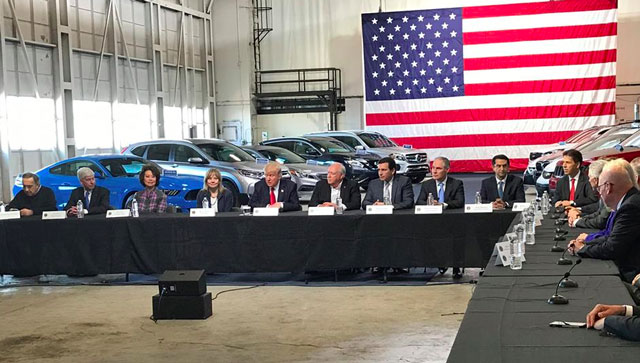
Washington, United States | AFP | The North American Free Trade Agreement (NAFTA) is a 23-year-old pact has boosted trade among Canada, Mexico and the United States.
It might now be renegotiated the White House said Wednesday, after Canada and Mexico agreed to do so “swiftly.”
US President Donald Trump lambasted the agreement during his campaign as “the worst trade deal maybe ever signed anywhere” and had threatened to terminate it once elected.
Here are details on what NAFTA is and who it benefits.
– What is NAFTA? –
The agreement took effect in 1994 and is one of the world’s the most important trade pacts, allowing nearly unfettered access for goods and services to a combined market of 478 million people in Canada, Mexico and the United States. It was negotiated by the Republican administration of George H.W. Bush but signed by his Democratic successor Bill Clinton.
NAFTA replaced a 1989 bilateral free trade deal between Canada and the United States which Ottawa has said it would fall back on if the current agreement was dumped.
NAFTA removed most tariffs on goods traded between the three partners, eased investment rules and allowed for more movement of workers between the countries.
Some goods are exempted from the accord, such as softwood lumber and dairy products, the source of recent tension between Canada and the United States.
– NAFTA advantages –
Prior to Trump’s election officials in the United States, Canada and Mexico routinely promoted free trade, notably praising their close ties under NAFTA and pointing to the jobs and wealth resulting from the agreement.
According to the NAFTA secretariat, nearly 40 million new jobs were created, including 25 million in the United States, over the first 15 years after the pact was ratified.
Canada raked in the largest share of foreign investment meanwhile.
– Trade explosion –
With the elimination of tariffs, commerce between the three nations has surged, but trade imbalances between Mexico and the United States have also skyrocketed.
Mexican exports to the United States increased sevenfold between 1993 and 2016, but less than threefold to Canada.
The US trade deficit with Mexico soared from a US$1.6 billion surplus on the eve of NAFTA to a US$60 billion deficit last year, US government data shows.
Canada’s trade deficit with Mexico also widened to US$7.5 billion in 2016, according to Canadian government statistics.
– Mexico-US exchanges –
Moving factories and jobs from the United States to Mexico has changed the dynamic of the trade relationship. Some 80 percent of Mexican exports go to the United States.
US automakers often send parts back and forth across the border before a car or truck is fully assembled. High-end products like computers and electronics are exported in both directions.
Trade in agricultural and food products is balanced, but the United States has a small deficit with Mexico in clothing and textiles.
– Canada, US still richest –
Despite attracting US and Canadian companies and creating jobs under NAFTA, Mexican economic growth continues to trail that of its northern neighbors.
Mexican per capita gross domestic product grew by a factor of 1.6 between 1993 and 2015, according to the World Bank. Canadian and US per capita growth more than doubled, meanwhile.
With a per capita GDP of about US$9,000 in 2015, Mexico is well behind Canada (US$43,300) and the United States (US$56,100)
 The Independent Uganda: You get the Truth we Pay the Price
The Independent Uganda: You get the Truth we Pay the Price



